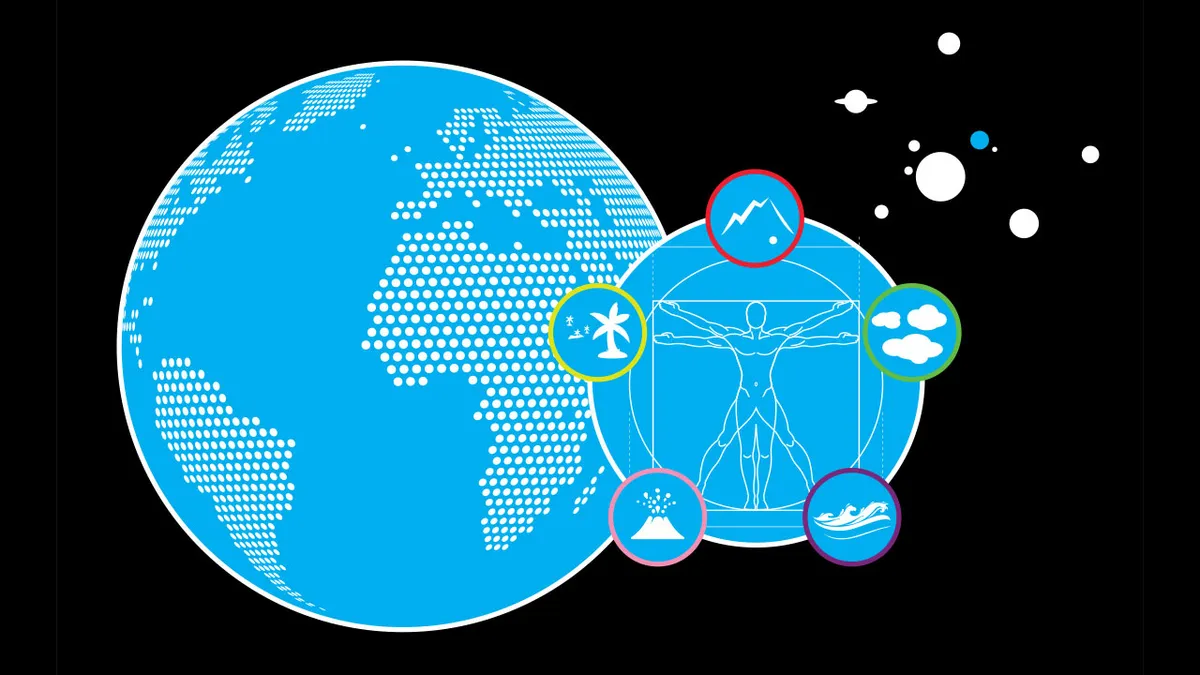There are some 196 countries on Earth, each with their own distinct flag, yet there is no flag to represent the planet as a whole. With space missions to other planets now becoming an almost routine occurrence, and Earth Day just around the corner, the team at BBC Focus magazine thinks it’s time to set this right and are asking for your help. What design would you want to see on a flag for planet Earth? We recognise this is a tough task, so we asked luminaries from the world of science and design for their ideas to help you get your creative juices flowing.
1
Tim Ruffle
Commercials Director at Aardman Animations, creators of Wallace & Gromit

I wanted to show the world as a flat illustration because you can never see all of the elements on one side of the planet. The idea is that the flat circle represents the Earth and it is divided up to represent the different parts that make up the Earth.
The surface water fills 71 per cent of the circle, land fills 29 per cent, 33 per cent of the land is desert, 9 per cent is the Antarctic etc. It’s kind of like an informal pie chart. The Sun and Moon are there to show that we have night and day. The idea was that it shows all of the things that make the Earth work and keep it ticking. I decided not to show any countries so that it isn’t political. If you look closely you can see that some of the trees are just stumps. That’s so that you can see the human impact on the trees and see that they are diminishing thanks to logging and deforestation.
2
Marcus Du Sautoy
Professor of Mathematics at the University Of Oxford

Carl Sagan’s sci-fi novel Contact chooses prime numbers as the way for his aliens to contact the Earth. These numbers have a universal character that transcends cultural, political and even galactic boundaries. I recently worked with an artist called Richard Rhys who runs a wonderful project called Pattern Foundry. We developed an artwork using prime numbers, and adapted it to make a flag.
It is based on something called the Ulam Spirals. The grid represents the numbers from one to 24 (each number is a square divided into two) arranged in an anticlockwise spiral starting from the middle of the flag outwards. The prime numbers are then coloured in as you spiral round. The colours and orientations of the squares represent different properties of the primes. A square is coloured purple if the prime number has a remainder of one on division by four, and green if it has remainder three. The half-green/half-purple square is the number two – the only even prime number.
3
Jim Al-Khalili
BBC presenter and physics professor

I wanted my flag to convey the beauty of our planet. The most distinctive thing about the Earth is its colours: the blue oceans, green land and white cloud. So I’ve reflected these in the flag’s colours.
As for the flag’s content, what tugs at the emotional heartstrings of humans is not going to mean anything to an alien civilisation – likewise, with aesthetic beauty. I wanted to choose a design that shows our ability to think, to create, and to imagine: something that’s not passive and that could only have been dreamt up by an intelligent, sentient species.
It’s no good sticking a mathematical equation down as that uses symbols we invented. Instead, my flag acknowledges our ability to use mathematics by displaying a visualisation of the Mandelbrot set – a famous example of a fractal. Superimposed inside the fractal pattern are two iconic images that are symbolic of our planet and life within it: a baby in a womb, and an image of the Earth as seen from space.
4
Helen Czerski
Physicist and BBC presenter

Our planet is fascinating because of the five systems it’s made up of: the oceans, atmosphere, life, rocks and ice. I’d like a flag that reminds us (and tells any non-Earthlings) that our civilisation can exist because it’s got a robust life-support system. We don’t stand apart from those five components – they shape us and we’re starting to shape them. A flag should represent your identity. The Earth gives us our identity and sets out our place in the Universe.
5
Fleur Isbell and Calle Enström
Designers at creativeconsultancy Wolff Olins, designers of the London 2012 logo

We’ve designed a multi-sensory flag that uses sight, sound, smell, touch and taste to represent our species. We didn’t want to be limited by a purely visual design. What happens if the aliens don’t have eyes but possess a super sense of smell or hearing?
We used all the colours in the visible part of the electromagnetic spectrum, and each colour is associated with a taste from Earth. So the red part might taste of strawberry; the yellow part of banana.
The flag also uses smells and sounds to communicate. Sound doesn’t travel in space, of course, so the sound waves are encoded in the shape of the flag. As the flag moves, smells of the sea, trees, rainstorms and food from Earth are released.
The flag could be hundreds of miles long. For the material, we like the idea of layering solids, liquids and gases. Maybe even jelly, if we want to show that we’re a playful species…
6
BBC Sky At Night magazine

A flag for Earth should state our place in the Universe – what better way to show that than through the stars. The constellations that we know so well are unique to us. In no other sky could you see the great bear of Ursa Major in the north, or the centaur archer of Sagittarius in the south.
The eight circles represent all the currently known planets of our Solar System. Though each is separate and different, all are linked together by gravity, forming one system. Together with the constellations, this creates a map of Earth’s place in the Galaxy.
The green band represents not only the ground but also all the life that can be found here, which is undoubtedly Earth’s defining feature in the Universe. Above that lies a thin white line representing the atmosphere, separating us from the infinite blackness of space.
Follow Science Focus onTwitter,Facebook, Instagramand Flipboard
